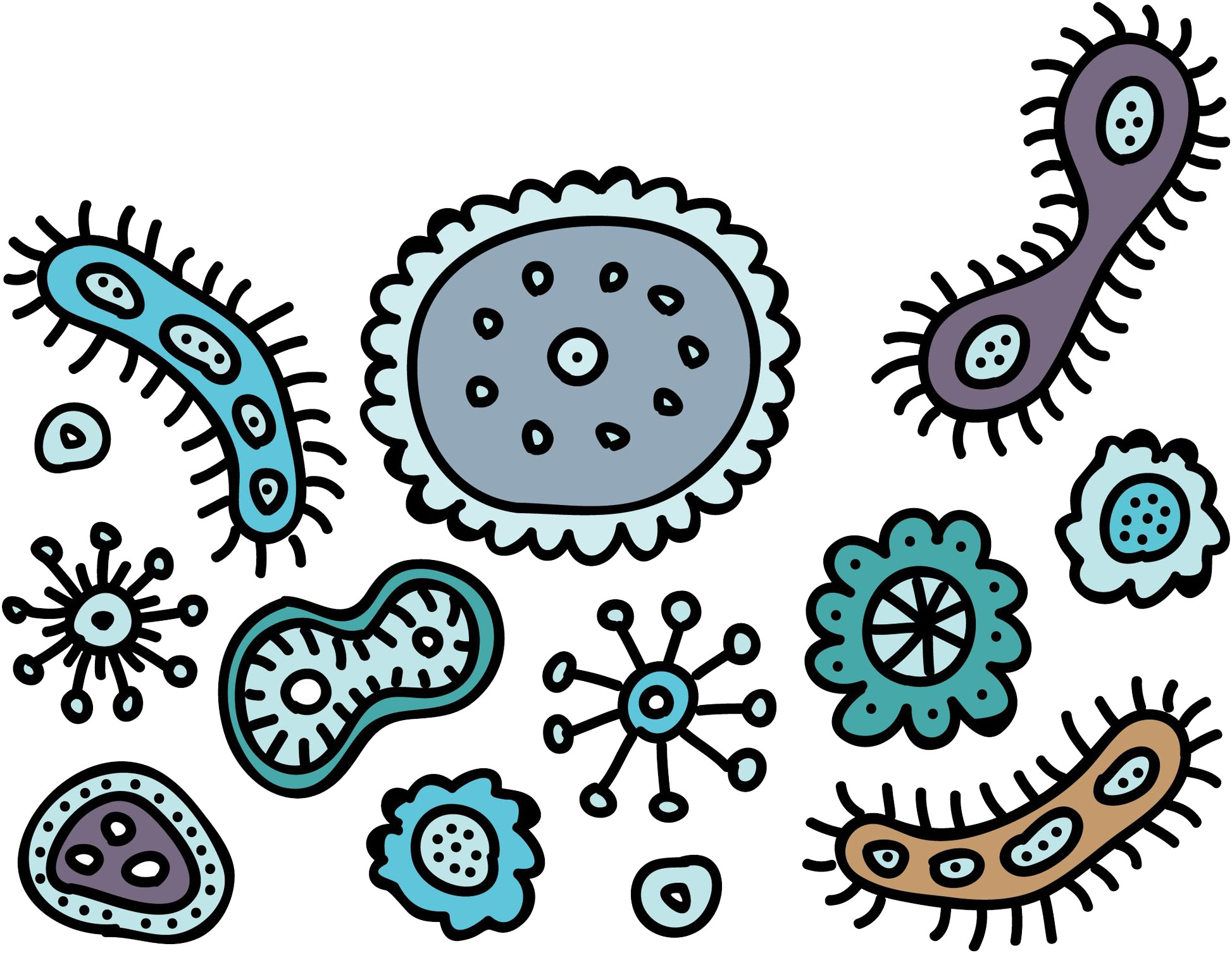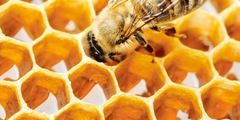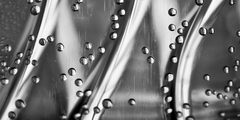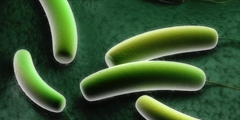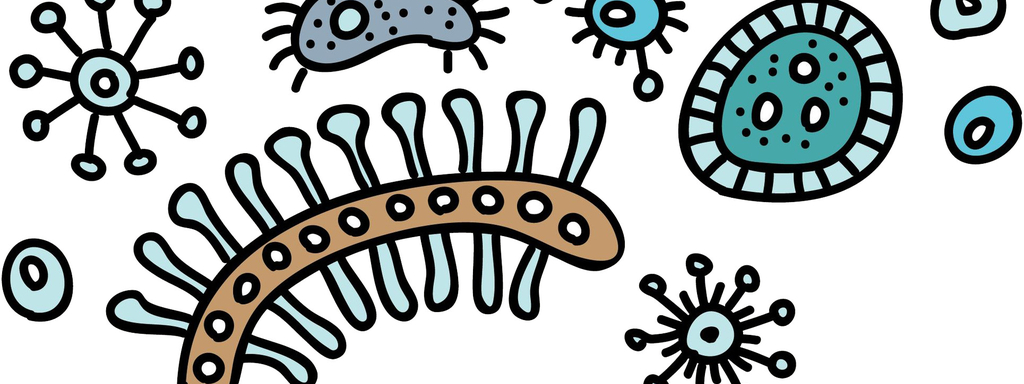
Bacteriën kunnen zich soms organiseren in structuren die
aan een meercellige organismen doen denken: biofilms. Deze worden
meestal gevormd aan oppervlakken, zoals tandplaques en
implantaten. Biofilms maken bacteriën nog weerspanniger voor
behandeling met antibiotica. Laboratoriumonderzoek bewijst dat
natuurlijke stoffen bacteriën in biofilms vatbaarder maken voor
(antibioticum)behandeling.
Beste bezoeker, u heeft geen toegang.
Enkel (web)abonnees hebben toegang tot tijdschriftartikelen. Het webabonnement is nog in de maak.
U kunt zich wel alvast (gratis) registreren en tal van andere webartikelen raadplegen!
Auteur
Verschenen in
Referenties
Normark S. Introducing npj Biofilms and Microbiomes. NPJ Biofilms and Microbiomes 2015; 1: 15004; 10.1038/npjbiofilms.2015.4.
Høiby N et al. The clinical impact of bacterial biofilms. Int J Oral Sci. 2011 Apr;3(2):55-65.
Nobile CJ, Johnson AD. Candida albicans Biofilms and Human Disease. Annu Rev Microbiol. 2015 Oct 15;69:71-92
Peng X et al. Cyclic di-AMP mediates biofilm formation. Mol Microbiol 2015 Nov 13. doi: 10.1111/mmi.13277. [Epub ahead of print]
Nazzari E, Torretta S, Pignataro L, Marchisio P, Esposito S. Role of biofilm in children with recurrent upper respiratory tract infections. Eur J Clin Microbiol Infect Dis. 2015 Mar;34(3):421-9.
Calò L, Passàli GC, Galli J, Fadda G, Paludetti G. Role of biofilms in chronic inflammatory diseases of the upper airways. Adv Otorhinolaryngol. 2011;72:93-6.
Galli J, Ardito F, Calò L, Mancinelli L, Imperiali M, Parrilla C, Picciotti PM, Fadda G. Recurrent upper airway infections and bacterial biofilms. J Laryngol Otol. 2007 Apr;121(4):341-4.
Post JC, Hiller NL, Nistico L, Stoodley P, Ehrlich GD. The role of biofilms in otolaryngologic infections: update 2007. Curr Opin Otolaryngol Head Neck Surg. 2007 Oct;15(5):347-51.
Sbordone L, Bortolaia C. Oral microbial biofilms and plaque-related diseases: microbial communities and their role in the shift from oral health to disease. Clin Oral Investig. 2003 Dec;7(4):181-8.
Zi MY et al. Mechanisms Involved in the Association between Periodontitis and Complications in Pregnancy. Front Public Health. 2015 Jan 29;2:290.
Høiby N, Ciofu O, Bjarnsholt T. Pseudomonas aeruginosa biofilms in cystic fibrosis. Future Microbiol 2010 Nov;5(11):1663-74.
Coburn J, Leong J, Chaconas G. Illuminating the roles of the Borrelia burgdorferi adhesins. Trends Microbiol. 2013 Aug;21(8):372-9.
Hodzic E. Lyme Borreliosis: Is there a preexisting (natural) variation in antimicrobial susceptibility among Borrelia burgdorferi strains? Bosn J Basic Med Sci. 2015 Jul 8;15(3):1-13.
Kaur S, Singh S. Biofilm formation by Aspergillus fumigatus. Med Mycol. 2014 Jan;52(1):2-9.
Beauvais A, Latgé JP. Aspergillus Biofilm In Vitro and In Vivo. Microbiol Spectr. 2015 Aug;3(4).
Beauvais A, Fontaine T, Aimanianda V, Latgé JP. Aspergillus cell wall and biofilm. Mycopathologia. 2014 Dec;178(5-6):371-7.
Fox EP et al. Anaerobic bacteria grow within Candida albicans biofilms and induce biofilm formation in suspension cultures. Curr Biol. 2014 Oct 20;24(20):2411-6.
Zhou G, Shi QS, Huang XM, Xie XB. The Three Bacterial Lines of Defense against Antimicrobial Agents. Int J Mol Sci. 2015 Sep 9;16(9):21711-33.
Cihalova K et al. Staphylococcus aureus and MRSA Growth and Biofilm Formation after Treatment with Antibiotics and SeNPs. Int J Mol Sci. 2015 Oct 16;16(10):24656-72
Marcinkiewicz J, Strus M, Pasich E. Antibiotic resistance: a "dark side" of biofilm‑associated chronic infections. Pol Arch Med Wewn. 2013;123(6):309-13.
Sun F et al. Biofilm-associated infections: antibiotic resistance and novel therapeutic strategies. Future Microbiol. 2013 Jul;8(7):877-86.
Høiby N, Bjarnsholt T, Givskov M, Molin S, Ciofu O. Antibiotic resistance of bacterial biofilms. Int J Antimicrob Agents. 2010 Apr;35(4):322-32.
Lewis K. Multidrug tolerance of biofilms and persister cells. Curr Top Microbiol Immunol. 2008;322:107-31.
Jhajharia K, Parolia A, Shetty KV, Mehta LK. Biofilm in endodontics: A review. J Int Soc Prev Community Dent. 2015 Jan-Feb;5(1):1-12.
Yucel-Lindberg T, Båge T. Inflammatory mediators in the pathogenesis of periodontitis. Expert Rev Mol Med. 2013 Aug 5;15:e7.
Pöllänen MT, Paino A, Ihalin R. Environmental stimuli shape biofilm formation and the virulence of periodontal pathogens. Int J Mol Sci. 2013 Aug 20;14(8):17221-37.
Krzyściak W et al. The virulence of Streptococcus mutans and the ability to form biofilms. Eur J Clin Microbiol Infect Dis. 2014 Apr;33(4):499-515.
Koo H, Falsetta ML, Klein MI. The exopolysaccharide matrix: a virulence determinant of cariogenic biofilm. J Dent Res. 2013 Dec;92(12):1065-73.
Xiao J et al. The exopolysaccharide matrix modulates the interaction between 3D architecture and virulence of a mixed-species oral biofilm. PLoS Pathog. 2012;8(4):e1002623.
Senadheera D, Cvitkovitch DG. Quorum sensing and biofilm formation by Streptococcus mutans. Adv Exp Med Biol. 2008;631:178-88.
Han L et al. Inferring Infection Patterns Based on a Connectivity Map of Host Transcriptional Responses. Sci Rep. 2015 Oct 28;5:15820.
Ferreira JA et al. Inhibition of Aspergillus fumigatus and Its Biofilm by Pseudomonas aeruginosa Is Dependent on the Source, Phenotype and Growth Conditions of the Bacterium. PLoS One. 2015 Aug 7;10(8):e0134692.
Castillo-Juárez I et al. Role of quorum sensing in bacterial infections. World J Clin Cases. 2015 Jul 16;3(7):575-98.
Davenport PW, Griffin JL, Welch M. Quorum Sensing Is Accompanied by Global Metabolic Changes in the Opportunistic Human Pathogen Pseudomonas aeruginosa. J Bacteriol. 2015 Jun 15;197(12):2072-82.
Pöllänen MT, Paino A, Ihalin R. Environmental stimuli shape biofilm formation and the virulence of periodontal pathogens. Int J Mol Sci. 2013 Aug 20;14(8):17221-37.
Sharma IM, Petchiappan A, Chatterji D. Quorum sensing and biofilm formation in mycobacteria: role of c-di-GMP and methods to study this second messenger. IUBMB Life. 2014 Dec;66(12):823-34.
Ramírez-Mata A et al. Networks involving quorum sensing, cyclic-di-GMP and nitric oxide on biofilm production in bacteria. Rev Argent Microbiol. 2014 Jul-Sep;46(3):242-55.
Srivastava D, Waters CM. A tangled web: regulatory connections between quorum sensing and cyclic Di-GMP. J Bacteriol. 2012 Sep;194(17):4485-93.
Jakobsen TH et al. Targeting quorum sensing in Pseudomonas aeruginosa biofilms: current and emerging inhibitors. Future Microbiol. 2013 Jul;8(7):901-21.
Sharma IM, Petchiappan A, Chatterji D. Quorum sensing and biofilm formation in mycobacteria: role of c-di-GMP and methods to study this second messenger. IUBMB Life. 2014 Dec;66(12):823-34.
Yong YC, Zhong JJ. Impacts of quorum sensing on microbial metabolism and human health. Adv Biochem Eng Biotechnol. 2013;131:25-61.
Leung V, Dufour D, Lévesque CM. Death and survival in Streptococcus mutans: differing outcomes of a quorum-sensing signaling peptide. Front Microbiol. 2015 Oct 23;6:1176.
Ramírez-Mata A et al. Networks involving quorum sensing, cyclic-di-GMP and nitric oxide on biofilm production in bacteria. Rev Argent Microbiol. 2014 Jul-Sep;46(3):242-55.
Veronica L, Saviuc CM, Chifiriuc MC. Periodontitis and Periodontal Disease - innovative strategies for reversing the chronic infectious and inflammatory condition by natural products. Curr Pharm Des. 2015 Nov 12. [Epub ahead of print]
Abidi SH, Ahmed K, Sherwani SK, Kazmi SU. Synergy between antibiotics and natural agents results in increased antimicrobial activity against Staphylococcus epidermidis. J Infect Dev Ctries. 2015 Sep 27;9(9):925-9.
El-Feky MA et al. Effect of ciprofloxacin and N-acetylcysteine on bacterial adherence and biofilm formation on ureteral stent surfaces. Pol J Microbiol. 2009;58(3):261-7.
Akinori Yanaka et al. Dietary Sulforaphane-Rich Broccoli Sprouts Reduce Colonization and Attenuate Gastritis in Helicobacter pylori–Infected Mice and Humans. Cancer Prev Res April 2009 2; 353
Upadhyay A et al. Combating pathogenic microorganisms using plant-derived antimicrobials: a minireview of the mechanistic basis. Biomed Res Int. 2014;2014:761741.
Khan MS, Ahmad I. Antibiofilm activity of certain phytocompounds and their synergy with fluconazole against Candida albicans biofilms. J Antimicrob Chemother. 2012 Mar;67(3):618-21.
Mohsenipour Z, Hassanshahian M. The Effects of Allium sativum Extracts on Biofilm Formation and Activities of Six Pathogenic Bacteria. Jundishapur J Microbiol. 2015 Aug 25;8(8):e18971.
Quah SY, Wu S, Lui JN, Sum CP, Tan KS. N-acetylcysteine inhibits growth and eradicates biofilm of Enterococcus faecalis. J Endod. 2012 Jan;38(1):81-5.
Ulusoy AT, Kalyoncuoğlu E, Reis A, Cehreli ZC. Antibacterial effect of N-acetylcysteine and taurolidine on planktonic and biofilm forms of Enterococcus faecalis. Dent Traumatol. 2015 Oct 29. doi: 10.1111/edt.12237.
Sethupathy S, Nithya C, Pandian SK. 2-Furaldehyde diethyl acetal from tender coconut water (Cocos nucifera) attenuates biofilm formation and quorum sensing-mediated virulence of Chromobacterium violaceum and Pseudomonas aeruginosa. Biofouling. 2015 Oct;31(9-10):721-733.
Veloz JJ et al. Antibiofilm Activity of Chilean Propolis on Streptococcus mutans Is Influenced by the Year of Collection. Biomed Res Int. 2015;2015:291351.
Sethupathy S, Nithya C, Pandian SK. 2-Furaldehyde diethyl acetal from tender coconut water (Cocos nucifera) attenuates biofilm formation and quorum sensing-mediated virulence of Chromobacterium violaceum and Pseudomonas aeruginosa. Biofouling. 2015 Oct;31(9-10):721-733.
Vandeputte OM et al. Identification of catechin as one of the flavonoids from Combretum albiflorum bark extract that reduces the production of quorum-sensing-controlled virulence factors in Pseudomonas aeruginosa PAO1. Appl Environ Microbiol. 2010 Jan;76(1):243-53.
Vandeputte OM et al. The flavanone naringenin reduces the production of quorum sensing-controlled virulence factors in Pseudomonas aeruginosa PAO1. Microbiology. 2011 Jul;157(Pt 7):2120-32.
Sarabhai S, Sharma P, Capalash N. Ellagic acid derivatives from Terminalia chebula Retz. downregulate the expression of quorum sensing genes to attenuate Pseudomonas aeruginosa PAO1 virulence. PLoS One. 2013;8(1):e53441.
Kumar L et al. Zingerone silences quorum sensing and attenuates virulence of Pseudomonas aeruginosa. Fitoterapia. 2015 Apr;102:84-95.
Gopu V, Meena CK, Shetty PH. Quercetin Influences Quorum Sensing in Food Borne Bacteria: In-Vitro and In-Silico Evidence. PLoS One. 2015 Aug 6;10(8):e0134684.
Vandeputte OM et al. Identification of catechin as one of the flavonoids from Combretum albiflorum bark extract that reduces the production of quorum-sensing-controlled virulence factors in Pseudomonas aeruginosa PAO1. Appl Environ Microbiol. 2010 Jan;76(1):243-53.
Sarabhai S, Sharma P, Capalash N. Ellagic acid derivatives from Terminalia chebula Retz. downregulate the expression of quorum sensing genes to attenuate Pseudomonas aeruginosa PAO1 virulence. PLoS One. 2013;8(1):e53441.
Vasavi HS, Arun AB, Rekha PD. Anti-quorum sensing activity of flavonoid-rich fraction from Centella asiatica L. against Pseudomonas aeruginosa PAO1. J Microbiol Immunol Infect. 2014 May 21. pii: S1684-1182(14)00069-3
Yin H et al. Tea polyphenols as an antivirulence compound Disrupt Quorum-Sensing Regulated Pathogenicity of Pseudomonas aeruginosa. Sci Rep. 2015 Nov 9;5:16158.
Farooqui A et al. Synergistic antimicrobial activity of Camellia sinensis and Juglans regia against multidrug-resistant bacteria. PLoS One. 2015 Feb 26;10(2):e0118431.
Süntar I, Oyardı O, Akkol EK, Ozçelik B. Antimicrobial effect of the extracts from Hypericum perforatum against oral bacteria and biofilm formation. Pharm Biol. 2015 Oct 29:1-6.
Kumar L, Chhibber S, Harjai K. Zingerone inhibit biofilm formation and improve antibiofilm efficacy of ciprofloxacin against Pseudomonas aeruginosa PAO1. Fitoterapia. 2013 Oct;90:73-8.
Khan MS, Ahmad I, Cameotra SS, Botha F. Sub-MICs of Carum copticum and Thymus vulgaris influence virulence factors and biofilm formation in Candida spp. BMC Complement Altern Med. 2014 Sep 15;14:337.
Mohsenipour Z, Hassanshahian M. The inhibitory effect of Thymus vulgaris extracts on the planktonic form and biofilm structures of six human pathogenic bacteria. Avicenna J Phytomed. 2015 Jul-Aug;5(4):309-18.
Derksen A et al. 3-O-galloylated procyanidins from Rumex acetosa L. inhibit the attachment of influenza A virus. PLoS One. 2014 Oct 10;9(10):e110089.
Structural features of flavan-3-ols, oligomeric proanthocyanidins, hydrolyzable tannins, depsides and building blocks of tannins tested for antiviral activity; compounds isolated from Rumex acetosa extract RA are marked by asterisk.
Kouidhi B, Al Qurashi YM, Chaieb K. Drug resistance of bacterial dental biofilm and the potential use of natural compounds as alternative for prevention and treatment. Microb Pathog. 2015 Mar;80:39-49.
Ocheng F et al. Inhibitory Effects on Oral Pathogens. Evid Based Complement Alternat Med. 2015;2015:230832.
Grenier D, Chen H, Ben Lagha A, Fournier-Larente J, Morin MP. Dual Action of Myricetin on Porphyromonas gingivalis and the Inflammatory Response of Host Cells: A Promising Therapeutic Molecule for Periodontal Diseases. PLoS One. 2015 Jun 29;10(6):e0131758.
Kachur K, Suntres ZE. The Antimicrobial Properties of Ginseng and Ginseng extracts. Expert Rev Anti Infect Ther. 2015 Nov 11. [Epub ahead of print]
Goh WK et al. Synthesis, quorum sensing inhibition and docking studies of 1,5-dihydropyrrol-2-ones. Bioorg Med Chem. 2015 Oct 23. pii: S0968-0896(15)30103-6.
Adonizio A, Kong KF, Mathee K. Inhibition of quorum sensing-controlled virulence factor production in Pseudomonas aeruginosa by South Florida plant extracts. Antimicrob Agents Chemother. 2008 Jan;52(1):198-203.
Khan MS, Zahin M, Hasan S, Husain FM, Ahmad I. Inhibition of quorum sensing regulated bacterial functions by plant essential oils with special reference to clove oil. Lett Appl Microbiol. 2009 Sep;49(3):354-60.
Husain FM, Ahmad I, Asif M, Tahseen Q. Influence of clove oil on certain quorum-sensing-regulated functions and biofilm of Pseudomonas aeruginosa and Aeromonas hydrophila. J Biosci. 2013 Dec;38(5):835-44.
Khan MS, Ahmad I. Biofilm inhibition by Cymbopogon citratus and Syzygium aromaticum essential oils in the strains of Candida albicans. J Ethnopharmacol. 2012 Mar 27;140(2):416-23.
Husain FM, Ahmad I, Khan MS, Al-Shabib NA. Trigonella foenum-graceum (Seed) Extract Interferes with Quorum Sensing Regulated Traits and Biofilm Formation in the Strains of Pseudomonas aeruginosa and Aeromonas hydrophila. Evid Based Complement Alternat Med. 2015;2015:879540.
Obua C et al. Antibacterial activities of extracts from Ugandan medicinal plants used for oral care. J Ethnopharmacol. 2014 Aug 8;155(1):852-5.
Rajendran N et al. Antimicrobial flavonoids isolated from Indian medicinal plant Scutellaria oblonga inhibit biofilms formed by common food pathogens. Nat Prod Res. 2015 Oct 28:1-5.
Onsare JG, Arora DS. Antibiofilm potential of flavonoids extracted from Moringa oleifera seed coat against Staphylococcus aureus, Pseudomonas aeruginosa and Candida albicans. J Appl Microbiol. 2015 Feb;118(2):313-25.
Perdoni F et al. Antifungal activity of Myriocin on clinically relevant Aspergillus fumigatus strains producing biofilm. BMC Microbiol. 2015 Oct 30;15(1):248.
Khan R et al. In vitro and in vivo inhibition of Streptococcus mutans biofilm by Trachyspermum ammi seeds: an approach of alternative medicine. Phytomedicine. 2012 Jun 15;19(8-9):747-55.
Khan AU et al. Novel compound from Trachyspermum ammi (Ajowan caraway) seeds with antibiofilm and antiadherence activities against Streptococcus mutans: a potential chemotherapeutic agent against dental caries. J Appl Microbiol. 2010 Dec;109(6):2151-9.
http://www.advancedhealing.com/dr-ettingers-biofilm-protocol-for-lyme-and-gut-pathogens/

